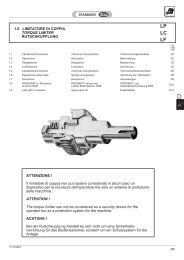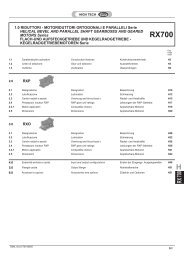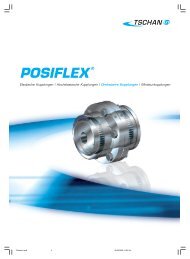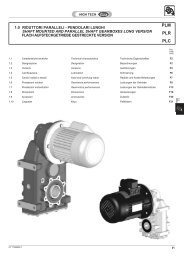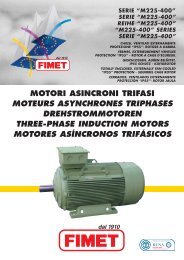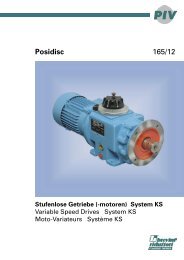Create successful ePaper yourself
Turn your PDF publications into a flip-book with our unique Google optimized e-Paper software.
1.3 Fattore di servizio<br />
Nel caso di riduttori a vite senza fine, occorre<br />
tener conto della temperatura ambiente<br />
(Tamb): il fattore di servizio va allora<br />
corretto come segue:<br />
Tab. 1.4<br />
Nel caso di variatore meccanico è necessario<br />
evidenziare inoltre che il numero di<br />
avviamenti massimo consentito senza<br />
provocare conseguenze sulla durata del<br />
variatore, non deve superare gli 8 - 10 al<br />
minuto<br />
A4<br />
1.3 Service factor<br />
Ambient temperature must also be taken<br />
into consideration when choosing<br />
wormgearboxes (Tamb): the service factor<br />
must be corrected as follows:<br />
Tamb<br />
Fattore di servizio / Service factor / Betriebsfaktor<br />
30 � 40 °C FS x 1.10<br />
40 � 50 °C FS x 1.2<br />
50 � 60 °C FS x 1.4<br />
About mechanical variator, note that the<br />
maximum number of starts allowed to preserve<br />
variator life is 8 - 10 starts per minute.<br />
1.3 Betriebsfaktor<br />
Im Falle der Schneckengetriebe muß die<br />
Raumtemperatur (Traum): berücksichtigt<br />
werden: der Betriebsfaktor muß also wie<br />
folgt bereinigt werden:<br />
� 60 °C Interpellare ns. Assistenza Tecnica / Contact our Technical Assistance Service / Bitte technischen Service hinzuziehen<br />
1.4 Rendimento<br />
(ed irreversibilità )<br />
Nei variatori meccanici vale circa 0.84 alla<br />
velocità massima.<br />
Nei rinvii angolari il rendimento dinamico<br />
RD può essere considerato pari a<br />
0.94-0.97.<br />
Nei riduttori a vite senza fine invece, è opportuno<br />
definire il rendimento in base al<br />
rapporto di riduzione distinguendo chiaramente<br />
fra il rendimento dinamico (questi<br />
valori sono riportati nelle tabelle delle prestazioni)<br />
e il rendimento statico (tab. 1.6).<br />
ll rendimento dinamico RD aumenta con il<br />
crescere dell’angolo dell’elica (bassi rapporti<br />
di riduzione), con il passare da oli minerali<br />
a sintetici e con l’incremento della<br />
velocità di strisciamento. Durante la fase<br />
di rodaggio il suo valore risulta essere<br />
sensibilmente inferiore rispetto a quello riportato<br />
nelle tabelle delle prestazioni.<br />
Il rendimento statico RS o rendimento<br />
dell’avviamento, è molto importante, al<br />
fine di una corretta scelta del riduttore,<br />
per quelle applicazioni in cui non si<br />
raggiungono mai le condizioni di regime<br />
(servizi intermittenti).<br />
Un riduttore è irreversibile staticamente<br />
(non azionabile dall’albero lento) quando il<br />
suo RS è minore di 0.5. In presenza di urti<br />
e vibrazioni tale condizione può non essere<br />
verificata.<br />
Un riduttore è irreversibile dinamicamente<br />
(blocco istantaneo della rotazione della<br />
vite qualora non sia più presente la causa<br />
della rotazione stessa) quando il suo RD è<br />
minore di 0.5.<br />
1.4 Efficiency<br />
(and irreversibility)<br />
Equal to 0.84 in case of variators at maximum<br />
speed.<br />
In right angle drives the dynamic efficiency<br />
RD can be considered equal to 0.94 and<br />
0.97<br />
It is advisable to determine the efficiency<br />
according to the reduction ratio in the<br />
worm gearboxes and to make a distinction<br />
between the dynamic efficiency<br />
(these values are shown in the performance<br />
tables)and static efficiency (see<br />
tab. 1.6).<br />
Dynamic efficiency RD increases gradually<br />
with an increase of the helix angle<br />
(low reduction04 ratios), with a change<br />
from mineral to synthetic lubricants and<br />
with an increase of rubbing speed. During<br />
running in period RD value is substantially<br />
inferior to the one listed in the performance<br />
table.<br />
Static efficiency RS or starting efficiency<br />
is very important with respect to<br />
the correct selection of the gearbox especially<br />
on applications where the optimal<br />
operating conditions are never<br />
attained (intermittent duty).<br />
A gearbox is statically irreversible (cannot<br />
be put into operation by output shaft),<br />
when its RS is less than 0.5. In the case of<br />
shocks or vibrations this can happen anyway.<br />
A gearbox is dynamically irreversible (instantaneous<br />
stop lock of wormshaft<br />
rotation if the cause of the same rotation is<br />
not present anymore), when its RD value<br />
is less than 0.5.<br />
Um die maximale Lebensdauer zu gewährleisten,<br />
sollten maximal 8-10 Schaltungen<br />
pro Minute getätigt werden.<br />
1.4 Wirkungsgrad<br />
(und Selbsthemmung)<br />
Mechanischen Verstellgetrieben ca. 0,84<br />
bei Maximalgeschwindigkeit.<br />
Der Wirkungsgrad der Winkelgetriebe<br />
beträgt 0.94-0.97. Bei Schneckengetrieben<br />
ist es hingegen zweckmäßig, den Wirkungsgrad<br />
ausgehend vom<br />
Untersetzungsverhältnis zu bestimmen,<br />
wobei zwischen dynamischem Wirkungsgrad<br />
(die Werte sind jeweils in den<br />
Leistungstabellen aufgeführt) und statischem<br />
Wirkungsgrad zu unterscheiden ist<br />
(siehe tab 1.6) . Der dynamische Wirkungsgrad<br />
RD erhöht sich bei einer Vergrößerung<br />
des Steigungswinkels (bei<br />
niedrigen Untersetzungsverhältnissen),<br />
bei der Verwendung von synthetischen<br />
anstatt Mineralölen und bei Erhöhung der<br />
Gleitgeschwindigkeit. Während der Einlaufzeit<br />
ist der Wert wesentlich niedriger als<br />
derjenige in den Leistungstabellen.<br />
Der statische Wirkungsgrad RS oder<br />
Anlaufwirkungsgrad ist bei der richtigen<br />
Wahl des Untersetzungsgetriebes<br />
sehr wichtig, speziell bei solchen<br />
Anwendungen, bei denen der optimale<br />
Betriebszustand nicht erreicht wird<br />
(Aussetzbetrieb).<br />
Ein Getriebe ist statisch selbsthemmend<br />
(kann von der Abtriebswelle nicht in Gang<br />
gesetzt werden), wenn sein statischer Wirkungsgrad<br />
(RS) unter 0.5 liegt. Bei Stößen<br />
oder Vibrationen kann dies jedoch trotzdem<br />
vorkommen. Ein Getriebe ist dynamisch<br />
selbsthemmend (sofortiges<br />
Blockieren der Schnekke, wenn die Ursache<br />
dieser Drehung nicht mehr vorhanden<br />
ist) wenn sein dynamischer Wirkungsgrad<br />
RD unter 0.5<br />
.<br />
CT16IGBD2



